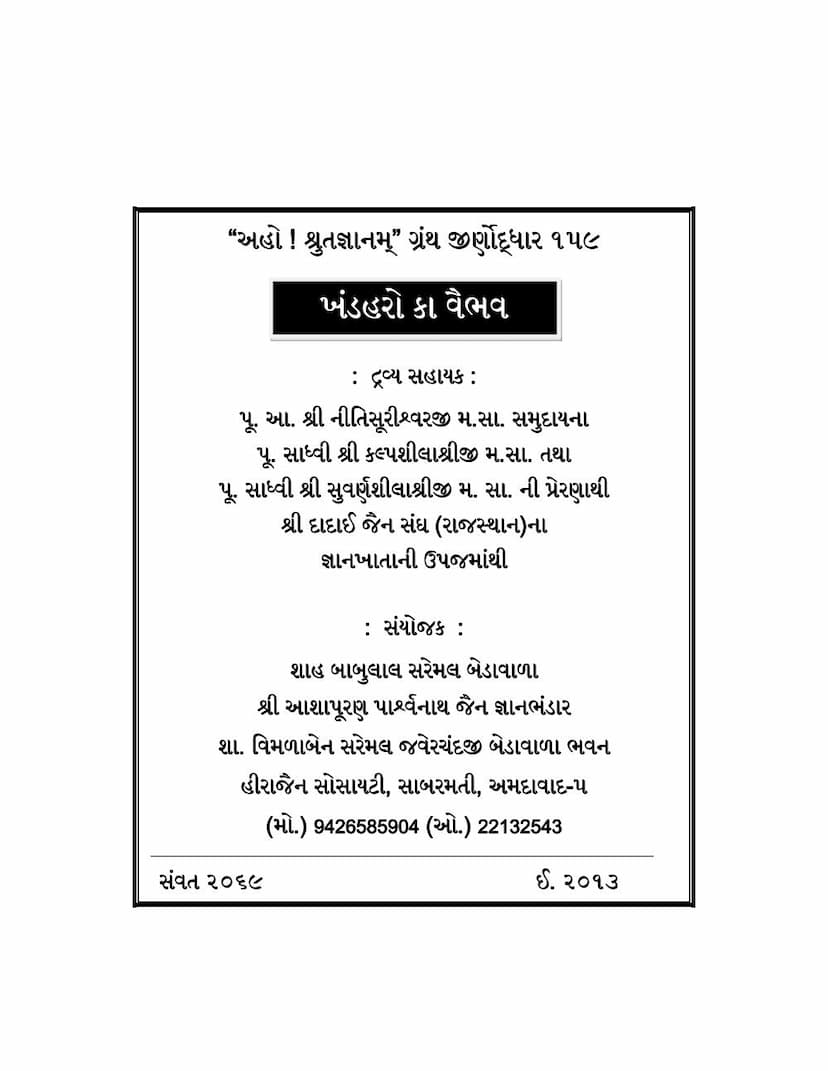Khandaharo Ka Vaibhav
Added to library: September 2, 2025

Summary
The book "Khandaharo Ka Vaibhav" (The Grandeur of Ruins) by Muni Kantisagar, published by Bharatiya Gyanpith, is a comprehensive exploration of Jain archaeological and artistic heritage, with a particular focus on the historical sites and artistic manifestations within the Madhya Pradesh region of India. The catalog link provided indicates that this work is part of a larger series by the Shri Ashapuran Parshwanath Jain Gyanbhandar aimed at digitizing and preserving rare and ancient Jain texts.
Here's a summary of the key themes and content discussed in the book, based on the provided text:
1. The Significance of Ruins and Cultural Heritage: The author emphasizes that ruins are not just remnants of the past but are repositories of immense cultural wealth and historical significance. They represent a legacy that transcends monetary value, embodying the ideals and values of past civilizations. The book posits that understanding these ruins is crucial for appreciating the "cultural grandeur" of India.
2. The Author's Approach and Passion: Muni Kantisagar is portrayed as a dedicated scholar with a deep passion for archaeology. He combines scholarly rigor with an artist's heart, finding profound beauty and meaning in the seemingly broken stones of ancient sites. His writings reflect an intimate connection with these ruins, where he perceives a flow of spiritual essence and a dialogue between the artist and the remnants of the past. He highlights the need for empathy and deep observation when studying these sites.
3. Jain Archaeology in Madhya Pradesh and Mahakoshal: A significant portion of the book is dedicated to the Jain archaeological findings in Madhya Pradesh, especially in the Mahakoshal region. Muni Kantisagar details his personal journeys and observations of various sites. He meticulously describes the architectural styles, sculptural details, and the current state of preservation of these ancient monuments.
4. The State of Neglect and Preservation Issues: The book poignantly highlights the unfortunate state of neglect and destruction that many of these invaluable ancient sites and artifacts face. The author expresses deep concern over the lack of protection and the casual attitude towards these historical treasures, which are often found in disrepair, repurposed, or even destroyed by locals and sometimes by officials for their own convenience. He laments the loss of inscriptions and sculptures due to vandalism and indifference.
5. Types of Archaeological Discoveries: The book covers a wide range of archaeological finds: * Sculptures and Idols: Detailed descriptions and analyses of various Jain sculptures, including different Tirthankaras, Yakshas, Yakshinis (like Ambika, Chakreshwari, Gomukha), and their iconographic variations across different regions and periods. He notes the influence of regional artistic styles and the evolution oficonography over centuries. * Architecture: Discussions on Jain cave temples, temples, stupas, pillar inscriptions, and architectural elements like torans (doorways), shikharas (spires), and mandapas. * Inscriptions and Literature: The importance of epigraphs and literary sources in understanding Jain history and archaeology is stressed. * Monuments and Memorials: The author also touches upon the significance of monuments commemorating monks and important figures.
6. Art Historical Analysis: Muni Kantisagar critically analyzes the artistic styles, influences, and evolutionary trajectory of Jain art in different regions. He points out similarities and differences between Jain art found in various parts of India, such as North India, South India, and the Mahakoshal region. He also notes the influence of Buddhist and Hindu art on Jain creations and vice versa, emphasizing the syncretic nature of ancient Indian art.
7. Specific Sites and Examples: The book provides detailed accounts of specific archaeological sites in Madhya Pradesh and surrounding regions, including: * Mahakoshal Region: A detailed study of Jain sites in this region, including temples, sculptures, and inscriptions, highlighting the rich artistic heritage. * Other Regions: Mentions of sites like Mathura, Ujjain, Gujarat, Saurashtra, Vidarbha, and Koshala, indicating the widespread presence of Jain heritage. * Specific Sculptures: Detailed discussions on particular significant sculptures, such as the Ambika and Gomedha Yaksha figures, the unique Ambika from Gujarat, and the Navagraha-infused Jina image.
8. Call for Preservation and Further Research: Throughout the book, Muni Kantisagar issues a strong call to action for the preservation of this fragile heritage. He urges the Jain community, government archaeological departments, and scholars to take more proactive measures to protect, study, and document these sites before they are lost forever. He advocates for scholarly research and publication to bring more light to the subject.
9. The Interplay of Religion and Art: The author explores how Jainism, through its emphasis on spiritual ideals, has inspired and shaped artistic creations. He explains that art, in the Jain tradition, is not merely decorative but serves as a medium for conveying spiritual messages and fostering inner contemplation.
10. The Concept of Beauty and Aesthetics: Muni Kantisagar delves into the philosophical aspects of beauty, suggesting that true beauty lies not just in external form but in the internal essence and the spiritual message conveyed. He links aesthetic appreciation with spiritual realization and the Jain ideals of self-control and detachment.
In essence, "Khandaharo Ka Vaibhav" is more than just an archaeological survey; it's a heartfelt tribute to the profound spiritual and artistic legacy of Jainism, presented through the lens of extensive personal research and deep reverence for the past. It serves as a vital record of Jain heritage, while also acting as a poignant reminder of the urgent need for its preservation.